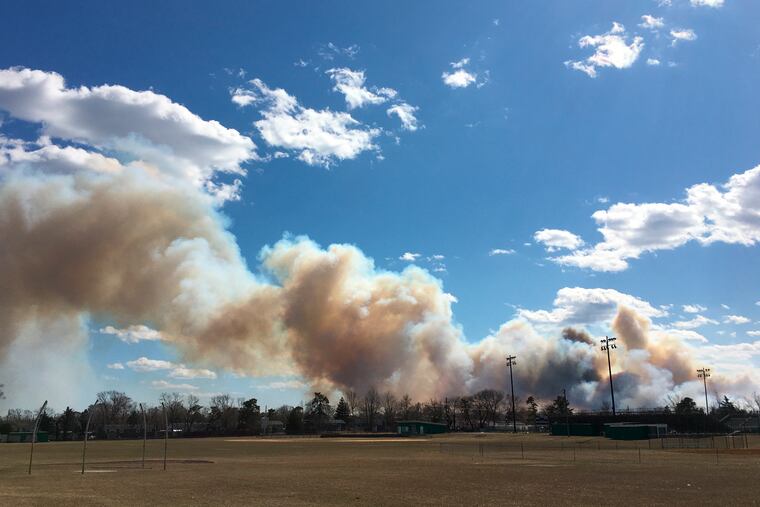Wildfire season in Philly region kicks off with blazes including a 170-acre scorcher in South Jersey
Steady high winds, combined with dry conditions, helped ignite a score of blazes in the region over the weekend, including a 170-acre fire in New Jersey that destroyed two buildings.

Steady high winds, combined with dry conditions, helped ignite a score of blazes in the Philadelphia region over the weekend, including a 170-acre fire in New Jersey that critically injured a firefighter, destroyed two commercial buildings, and forced the evacuation of residents.
The fire in Lakewood, Ocean County, at the edge of the Pine Barrens, began burning Saturday, and continued through Sunday night, causing evacuations in Brick and shutting down the Garden State Parkway until it was contained. A New Jersey Forest Fire Service firefighter remained in critical condition at a nearby hospital as of Monday afternoon.
State fire officials called reports that the fire was the result of a prescribed burn conducted to clear dead brush “absolutely false.”
Greg McLaughlin, the state’s fire warden, said the fire began in a forest that had not seen a fire in 40 years, so there was a lot of fuel built up on the ground. The woods where the fire occurred, the exact location of which officials did not disclose, are near a heavily developed area.
“This particular fire moved very quickly,” McLaughlin said.
Residents of Brick who were evacuated were cleared to return home by 7 p.m. Sunday.
Caryn Shinkse, a spokesperson for the fire service, said that low temperatures overnight helped suppress the fire. She said that the fire is likely to “burn and smolder” Monday east of the Garden State Parkway and north of Route 70, but that it was 100% contained and that all roads were open.
Two mixed-use professional/commercial structures and about eight outbuildings were destroyed by the fire.
Officials said 59 wildfires broke out Sunday under “red flag” conditions, a combination of high winds and low humidity, that began 8 a.m. and expired 5 p.m. Monday.
The Lakewood fire was the biggest among many fires throughout the region starting Saturday. Blazes were reported in Quakertown, Newtown, Newlin Township, West Norriton, and Philadelphia in Pennsylvania; and in Delran, Plumstead, and Jackson Township in New Jersey. Most were brush fires, fanned by high winds particularly on Sunday.
The National Weather Service and fire officials in the region were already on high alert going into the weekend because conditions were ripe for fires. March is a treacherous time for blazes, and one of New Jersey’s worst in recent years occurred in March 2019 with the Spring Hill fire that burned more than 11,000 acres in the Pine Barrens, starting with embers that spread from an illegal bonfire, fueled by wind.
Typically, fire threats are highest in mid-March through May. In March and April, vegetation and trees have not yet fully grown new leaves that retain water, slowing fire. In addition, with so little shade, forest floors tend to dry out.
The Inquirer reported Saturday that it could be a busy weekend for firefighters, due to the region experiencing the long run of dry days and winds set to gust to 35 mph or more. Philadelphia officially hasn’t had a drop of precipitation since March 1 — the longest March stretch since 1987.
Though wildfires are a threat in Pennsylvania, they are more so in New Jersey with its roughly 1.1 million acres of pinelands. State officials say the potential for “large catastrophic fires” exists because of the nature of the Pine Barrens.
» READ MORE: New Jersey's Pine Barrens are a 'tinderbox'
The Pine Barrens’ dry, sandy soil prevents vegetation from decomposing, leading to lots of potential fuel on the forest floor that has built up for decades in some areas. Pitch pine, which naturally is highly flammable, needs fire to release seeds from cones. Meanwhile, the Pinelands’ 1,819 square miles of connected shrub oak, laurel, and blueberry create a dense link to the tree canopy, allowing fire to spread explosively, similar to some conditions in California’s forests. On top of all that, wind blows uninterrupted across the flat landscape.
Winds in excess of 40 mph racked New Jersey’s coast on Sunday, according to the National Weather Service. In Pennsylvania, wind speeds reached 49 mph at White Clay Creek in Chester County. And, though it might have felt cooler because of the wind, temperatures reached a high of 59 in Philadelphia, seven degrees above normal.
Katie Dildine, a fire operations technician with Pennsylvania’s Division of Forest Fire Protection, said that temperature, wind, and moisture all play a role in fires, which tend to rage in afternoons, the warmest part of the day. Some of the top layer of fuels, such as leaf and grass, have been drying out since the snowmelt, allowing fires to burn and spread quickly.
But the wind was key, she said. Not only does it help dry out that fuel, but tosses embers into the air, creating more fire. It can push fires up, igniting tree canopies.
“The weather this past weekend showed prime conditions for fire,” Dildine said.